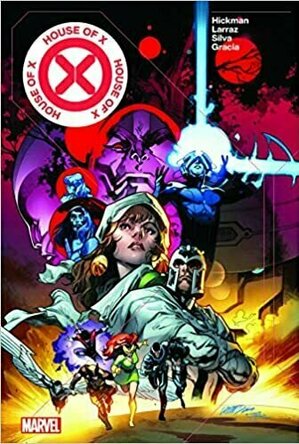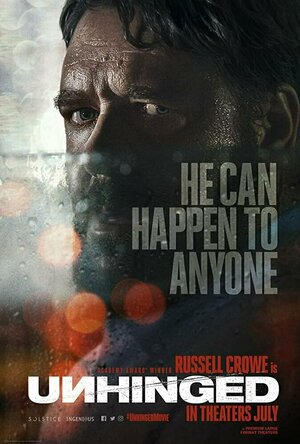Joe Goodhart (27 KP) rated House of X/Powers of X in Books
Nov 30, 2020
***
Say what you want about Marvel and their annoying reboot kerfuffles, but this whole "Dawn of X" that Jonathan Hickman is helming? FUCKING BRILLIANT, okay?!!? I swear to ya, the X-books haven't been this exciting or even remotely relevant in about twenty years! And as some who's been reading the X-books since the late 70's (yeah, I'm THAT old!), you can be sure that means something!
I have been bored with Wolverine's character the last handful of years. Other than the film LOGAN, I thought his character was overused and something of an ass, if I have to be honest. However, here? Holy crow, I am digging the ol' canucklehead again! Thank you, Mr. Hickman!
And I am going to keep this next bit Spoiler-free, just in case there is anyone reading this review and they have not yet finishing a'readin' it... Who knew [SPOILER-FREE] was a frikkin' mutant?! Again, I am a reader of the X-Men since the late 70's, but I still never had an even inkling that they were a mutant! And the way it was all presented? EPIC! I wanted to hate it, because it sounded so frikkin' trope-ish, without any redemptive potential! None of us likes to be proven wrong, but in this, yeah, I'll take it! Hickman did a smashing job with this plot point, one in which I am apt to conclude that when "Dawn of X" reaches its pinnacle (whenever this is.. <u>Thanks, COVID!!</u>), it's gonna come back around and it's a'gonna pack one hell of a punch!
<a data-flickr-embed="true" href="https://www.flickr.com/photos/188153395@N04/50081223842/in/dateposted-public/"; title="Image00016"><img src="https://live.staticflickr.com/65535/50081223842_cb1c47d5be_n.jpg"; width="220" height="218" alt="Image00016"></a><script async src="//embedr.flickr.com/assets/client-code.js" charset="utf-8"></script>
And I am fairly certain that what I am about to say is not going to be a spoiler, as I feel this has been true for some time now, but good Lord, Professor X is a dick! He is playing chess, with a board in his head that only he knows of, and anyone who is close to him gets relegated to "pawn status"!
I totally get where he, Erik (Magneto) and [SPOILER-FREE] are working towards with the whole mutant-nation of Krakoa, I truly do! But, with Xavier keep his hand of cards close to his chest, it seems sketchy at best! While we have seen Xaviers in past X-books where he wasn't as good as we thought, but it got old hat, y'know? Here? Yeah, I'm in for the long haul, as I am curious where this is all going to go and I suspect it's not going to go well as far as Xavier is concerned!
And amaz-a-balls as Hickman is with all this, it would be so unbecoming of me if I didn't address the fab art on both series! We had Pepe Larraz on HoX, while R.B. Silva handled the art for PoX. And let me tell ya, both of them did bang-up jobs, really bringing the icing for two already outstanding "cakes"! Bravo, gentleman, bravo!
So, time to wrap this up.. If you have any vested interest in all things mutant-related and have felt severely disappointed in the way things have been handled for the last twenty years plus, then you sincerely owe it to yourself to read this book! Worse case scenario? You're a closed-minded S.O.B., like I used to be, and there's just no pleasin' yer ass!
Peace. y'all!
Emma @ The Movies (1786 KP) rated Peterloo (2018) in Movies
Sep 25, 2019
If you've read some of my comments before about real-life event films you'll know that I struggle with the fact that it feels like I'm judging the subject rather than the film itself. Peterloo is no exception.
There is a truly impressive cast bringing this story to life. Lots of faces you'll recognise from one thing or another. I did have to stop myself from exclaiming out loud "Jack Boswell!" when he popped up and that certainly wasn't the only pointing at the screen moment. Performances all round were very good, whether they be someone to sympathise with, or someone to loathe.
You use the word massacre in the description of a film and you know it isn't going to be an easy watch. Unfortunately it was a difficult watch for a completely different reason. This film didn't seem accessible at all. You have to applaud them for wanting to bring a whole story to the screen without cutting lots of pieces out. The timeline seems to generally flow well and it did feel like we were getting the whole journey from start to finish.
Here's where I have a major problem.
The sheer length of this film. While I don't doubt that all the bits were important it honestly felt very repetitive. That coupled with the language made it a very dry watch. I nearly gave up and left. The couple behind me did. Which was actually a godsend because once they did I didn't feel so bad about having to move about to stop myself dozing off. This could easily have been 45 minutes shorter than it was, sacrificing something from the film would have given it a quicker pace to draw you.
What upset me most about this is that the powerful ending that was done so well felt entirely swamped by the long and drawn out beginning. When the scene unfolds you know what's coming but there's no way to prepare yourself for what they've created on the screen. In that moment I was thankful that I'd managed to stick it out just to get to that point. It was done in such a way that you completely understood what was happening and it came with an emotion that brought this tragedy shockingly to life.
Sadly that moment was stolen by this film's villain, time. This scene just kept going. There was a moment where it felt like it had come to a close... and yet it went on. I wasn't entirely surprised with that after seeing the beginning of the film, but I was disappointed. To add insult to injury we were given a brief dialogue at the end that felt very much like an after thought. And with that, I was done.
This is yet another film I've seen recently that felt like it would have been more suited to a multi episode TV series. It had very clear parts and I can't help but think that it would have benefited from being broken up into more manageable sections.
What you should do
Unless you're a massive history enthusiast I can't recommend this one to you. I really feel like your time would be better spent researching the story on the internet or finding a book in the library about it.
Movie thing you wish you could take home
It's difficult to want for anything in this period of history, but there's no denying that I would love to give that printer a go.
Becs (244 KP) rated Ember Burning in Books
Oct 2, 2019
Okay, so I was honestly really looking forward to reading this novel when I first received it in the mail that I’m kicking myself in the rear end for not picking it up sooner. I was shocked that it was exactly everything I was looking for in a young adult fantasy novel.
It’s got some witchiness to it. It’s got an adventure in it. And it’s got the best thing known to man, love. Fast-paced with well-rounded characters that make you either hate them or love them with a hint of history underlain throughout the novel. What more can I say about this wonderful book?
Genre: Paranormal, Fantasy, Young Adult
Reading Level: High School and up
Interests: Witch’s, Egyptian hieroglyphics, darkness
Style: Not so light but also not a heavy read. Very fast-paced – which I loved.
Difficulty Reading: NO, I could not put this book down. Oh my goodness, Jennifer Alsever has such a unique way of writing. At first, I was a little annoyed that there were so many sentences that could be switched to, ya know, longer sentences which leads to a way easier read. But they grew on me and as I started to get further into the book, I understood why it was written in such a way. Because that is the personality of the main character Ember. It definitely helped understand her more as an individual, rather than just another character in a book.
Promise: A mystery meets fantasy – it delivers.
Insights: Honestly, none. I wouldn’t change anything in Ember Burning even if it meant saving the planet. (Okay, maybe I might change stuff to save the planet. But that’s our home for crying out loud.) Ember Burning is such a well-written novel that leaves you wanting to continue on her journey with her in Oshun Rising and Venus Shining. (Which by the way, is the rest of the series.)
Ah-Ha Moment: WHEN EMBER AND TRE KISS. (Yes, that needed all caps.) Awh man, I love me a good romance. Especially one so sweet and simple like Ember and Tre’s. **SPOILERS AHEAD** I mean it’s such goals to be laying out talking about life and then turning to each other, kissing, and then both admitting that you wanted to do that for a while now. Like OH MY GOD, I’m seriously dying over here. **SPOILERS END** I ship Ember and Tre so hard and Lilly, Zoe or this redhead b**ch better not get in the way of their love. I’ll come after them. (‘I kill you!‘)
Favorite Quote: “Of course I know this is ridiculous. What I’m doing. Going to Trinity Forest. Alone. Like the freak show I am. The girl who goes off the tracks. Who obsesses about missing people, about what happens in Trinity. But the mystery of Trinity calls to me. If I disappear, so be it.” – Girl, you ain’t no freak show. You are so perfectly normal. And if you’re a freak show well, I guess I’m a freak show too.
What will you gain: A love for Ember and her determination to get out of the black vortex known as Trinity Forest. A hate for Zoe’s sweet yet bossy attitude of not giving a shit about anything. A love-hate for Lilly and her psychotic yet charming sides. A love for Tre, my favorite character in the entire novel.
Aesthetics: The cover. The way Tre smiles. The entire book. The way Tre looks. The way Jennifer Alsever describes Synesthesia within Ember’s mind. Have I mentioned Tre and how much I really dig him?
“Would you sacrifice your future to forget your past.”

10bii Financial Calculator
Finance and Utilities
App
Look no further, you have found the best Financial Calculator app available. In-App Purchase:...

Baby Monitor for IP Camera (Amcrest, Foscam, etc.)
Utilities and Lifestyle
App
BABY MONITOR is created by parents for parents to keep an eye on our babies using IP cameras. Free...

Voice Answer Lite
Business and Reference
App
Voice Answer gives answers on many topics and can assist you with several tasks, all voice...

Banff Lake Louise Yoho GyPSy Guide
Travel and Navigation
App
GyPSy Guide GPS driving tour of the Banff, Lake Louise and Yoho areas is a great way to the see some...
![[5 CD]Classic Guitar [100 Classical music]](/uploads/profile_image/36f/31b0614a-0508-428e-8e43-f6757a04c36f.jpg?m=1522361064)
[5 CD]Classic Guitar [100 Classical music]
Music
App
3 Series 5CD 100 most classic Guitar ▪ [2 CD]Masters of the Guitar ▪ ▪ [2 CD]Spanish Guitar...
Lee (2222 KP) rated Unhinged (2020) in Movies
Sep 2, 2020
We’d already seen just how angry Russell Crowe’s character is (billed as ‘The Man’, although he later introduces himself as Tom Cooper), courtesy of a shocking little pre-credits scene. Sitting in his car at night, rain beating down on the car as he breathes heavily and pops some pills into his mouth. Slowly turning a wedding ring on his finger, he removes it, tossing it behind him onto the backseat. Taking a hammer, he gets out of the car and walks to the front door of the house he’d parked outside, before smashing it down and proceeding to use the hammer on the occupants. He’s clearly not the kind of person you want to get on the wrong side of.
The person that does manage to get on his wrong side is Rachel (Caren Pistorius), who’s also having a pretty bad day of her own. Waking up late on the sofa, we learn that she’s currently going through a divorce, with her ex-husband wanting her house. She’s also late in taking her son to school, so when they hit heavy traffic along the way, it’s the last thing she needs.
At some traffic lights, the large SUV she’s sitting behind doesn’t budge when the lights turn green, so Rachel lets out a series of long beeps on the horn, before eventually pulling around the SUV to continue on her way. Unfortunately for her though, when they hit more traffic further down the road, the SUV pulls up alongside her, and when the window rolls down, we see that it’s ‘The Man’ behind the wheel. He’s calm at first, if a little on edge, but after apologising for his mistake, demands the same from Rachel before they go their separate ways. Unfortunately though, Rachel isn’t prepared to offer an apology. “I need you to learn what a bad day is and I need you to learn how to say sorry” he growls, before Rachel pulls away, believing that to be the end of it.
What follows is an intense game of cat and mouse, as ‘The Man’ relentlessly stalks Rachel through the roads and highways. Just to make things worse, ‘The Man’ manages to get hold of Rachel’s phone and starts to threaten and target her close friends and family. We’ve already seen just how Unhinged he can be, and there’s more of that as the movie progresses and he gets a chance to carry out some of those threats. He’s not just out to kill Rachel, but to give her the worst possible day he can before that moment arrives.
Crowe is suitably menacing – overweight and sweaty, taking out anyone who gets in his way and methodical in his determination to catch Rachel. The movie does try to humanise him a little at times though, as we discover that he’s been through a relationship breakdown, and was laid off work just a few weeks short of retiring, as if trying to provide some justification for his behaviour.
Unhinged comes in at just over 90 minutes and proved to be a real intense, gut wrenching roller-coaster ride. I don’t know if I was just a bit giddy at being back in the cinema for the first time since March, but I found it to be a lot of fun.

Summer Heat: A Steamy Romance Collection
Caitlyn Lynch, Christina Rose Andrews, Ariel Bishop, Líadáin Douglas, Annika Steele, Gwen Marshall, Abbigail Clark, Livvy Ward, T.D. Crawls, Ava Bari, Avery J. Heath, Tally Bane, Sera Taíno, Moxie Rivers, Siobhan Kearney, Cynthia Miller and Tricia Ramey
Book
A collection of 17 steamy short stories (5,000 - 10,000 words) by new and established romance...
Anthology Contemporary Romance



